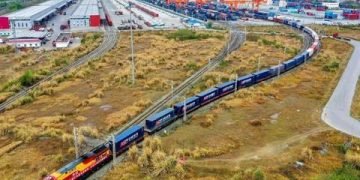In recent years, geopolitical tensions in the Red Sea region have escalated, posing challenges to global trade and transport. Amidst these uncertainties, the China-Europe freight trains have emerged as a stabilizing force, providing a reliable and efficient alternative for transporting goods between Asia and Europe. This development is part of China’s ambitious Belt and Road Initiative (BRI), a comprehensive infrastructure and economic development project aimed at enhancing connectivity and cooperation between nations.
The Growing Significance of China-Europe Freight Trains:
The China-Europe freight trains have gained significant traction as a vital component of the BRI, fostering economic ties between China and Europe. In light of rising tensions in the Red Sea region, the importance of these trains has become even more pronounced, offering a secure and stable alternative to traditional sea routes.
- Reducing Dependency on Maritime Routes: The Red Sea, a critical maritime passage, has witnessed increased geopolitical tensions, including piracy concerns and political instability. China-Europe freight trains provide a reliable alternative, reducing dependency on vulnerable sea routes and mitigating risks associated with maritime transport.
- Efficiency and Speed: The freight trains offer a faster transportation option compared to sea freight. The overland route significantly shortens the time it takes for goods to reach their destination, contributing to a more agile and responsive supply chain. This is particularly crucial in times of heightened geopolitical tensions where rapid and secure transport is essential.
- Diversification of Transport Networks: The BRI, through the China-Europe freight trains, contributes to the diversification of global transport networks. By establishing multiple routes connecting Asia and Europe, nations can better navigate geopolitical challenges, ensuring the continuity of trade and economic activities.
- Enhanced Connectivity: The BRI aims to create a network of interconnected infrastructure, and the China-Europe freight trains play a pivotal role in achieving this goal. As these trains traverse through various countries, they foster enhanced connectivity, promoting economic development and cooperation along their routes.
- Economic Benefits for Participating Countries: Countries along the China-Europe freight train routes stand to gain economically, as increased trade and transportation activities spur local development. This economic boost can contribute to stability in regions affected by geopolitical tensions, offering a path towards prosperity and cooperation.
Conclusion:
Against the backdrop of escalating tensions in the Red Sea region, the China-Europe freight trains under the Belt and Road Initiative serve as a stabilizing force in global trade. By providing a secure, efficient, and diversified alternative to traditional sea routes, these trains contribute to the resilience of the global supply chain. As nations continue to navigate geopolitical challenges, the importance of such initiatives becomes increasingly evident, fostering economic cooperation and stability along the Silk Road Economic Belt.























